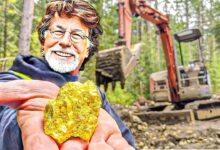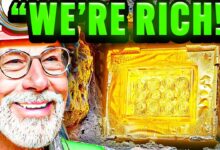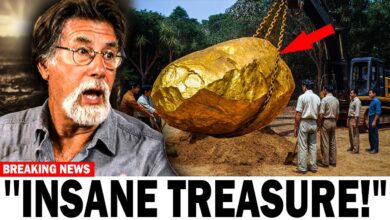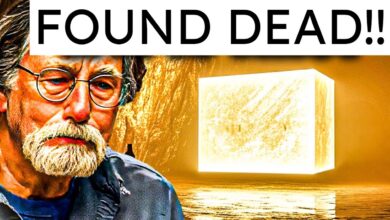Oak Island Plus, Episode 30, The Final Answer
Oak Island Plus, Episode 30, The Final Answer

Hi, this is Robert Clworthy and you are listening to Oak Island Plus, a discussion of Oak Island and other mysteries from around the world.
Here are your hosts, James McQuiston, Oak Island theorist and author, along with John Hamills, PhD and historical researcher.
Get the whole story right here, brought to you by Rabbit Hole Investigations.
Hey everybody, welcome back to Oak Island Plus and this is episode 30.
Seems like it was just episode 29.
My god, isn’t that great? It’s unbelievable.
I’m Doc Hamls and uh Jim McQuiston and we’ve been teaming up here for going on three years um between books and videos and everything else and our uh Facebook page.
So Jim, today is going to be sort of an abbreviated show, right?
Yep.
So it has an interesting title, the final answer.
Do we have the final answer?
Well, you know where we came up with that was we were having a a strategy meeting a month ago or so, early October, early September over omelets, over omelets.
And uh Doc said, you know, they probably already have the answer.
There is so much data that we’re still crunching.
So much data that they’re still crunching and when they’re on the island, they have to uh keep their nose to the grindstone to find stuff during the good weather, you know.
So they they’re they’ve amassed so much data they they inherited all of Dan Blankenship’s data that Judy Rudabish who’s Judy Rudabush who is such a great archivist is going through that paper by paper trying to see trying to look for clues.
I know Steve Gupt is uh is trying to uh get better GPS coordinates in some areas and log in what was found at those areas trying to make some kind of a map out of this.
Even Lar told us in his show that he was uh that the archaeology study was going on whether the show or not it was going to keep on going.
So, there’s just so much to do and there’s been a lot for us to do.
So, uh I I drew a comparison.
Remember, I said this is like the uh Indiana Jones movie where they take the Ark of the Covenant in a in an unlabeled box and they put it in that great big warehouse.
They’ve got thousands of artifacts.
They’ve got to they can’t have gone through all that and figured it all out, I don’t think.
And even Doug had told me that one year that there’s a rumor that Dalhausza University has a whole room full of Oak Island artifacts.
So, uh, all that stuff, you know, it’s pretty expensive to get carbonated and it ruins it generally ruins it.
But all of that stuff needs study and our work needs more study.
And so, uh, it’s quite possible that the final answer is out there right now with all the other theorists, you know, 12, 14, 16 other theorists, whatever, uh, refining their theories.
We’re refining our theories.
Judy’s looking through paperwork.
The archaeology team is dating items or whatever that the answer could be setting right there.
Or the final it could be just an innocuous little tidbit that all of a sudden we go, “Holy cow, there’s the missing link.”
Yep. Right.
And we found that in in a lesser scale when we have a hole in a story that we’re trying to build and then two or three days down the road, you’re looking at a book and you go, “Oh my god, that was just like me finding out last month that George Keith was a partner with William Alexander.
Who knew that? I never knew that in all the years I’ve been working on this, you.
So, you know, you find out those little tidbits and you fill in the gap and fill in the gap.
So, uh it because it’s only going to probably be uh solved through historic research and artifact identification and all that, unless they find a notebook that said, “Hey guys, this is what we’re up to, 1200 years ago or 400 years ago or whatever.”
That’s how it’s going to be found.
And it might already be found.
We just don’t know it.
We just we and they just need to keep crunching the data.
Crunching the data.
And in our case, we stay wide open.
We don’t always say we’re right because we’ve corrected ourselves and, you know, realized we had the wrong Douglas or the wrong Gordon only to discover they had two guys with the same name and we had to sort through that family line.
Well, and the Hoststone’s an example cuz we thought there was a chance that the cross on that could be a Knights of Malta cross.
Then we found out that no, the whole thing was a surveyor placed in 1817.
So, and yeah, that’s a good point because that could happen to them.
Judy could be on a trail or something and go, “Oh, wait a minute. I thought it was this, but it’s obvious it was this or any one of them.”
So, uh, kind of in reverence or whatever, out of respect for them getting a new start here this year, um, we thought maybe we’d pull back just a little bit.
Uh, maybe like you might call it a hiatus.
We’re not walking away from it, but just let see how things develop, see what they find.
You know, we’re going to obviously still be doing uh our stuff.
Fun hope to have a new book out pretty soon on the Mary Queen of Scots code and actually tied in with the beaver uh pelt.
Oh wow. Hunting.
It’s kind of a combination book.
But all those books takes forever to do.
I mean it it’s just unbelievable on them.
But anyway, so we’re not walking away from the mystery at all.
We’re just going to back off a little bit and let things dwell, right?
Let the they dig up whatever new holes they’re going to dig up.
Tied in, tied in, tied in, whatever Lar’s going to figure out.
Judy’s going to figure out.
But we do have a couple of bonus discoveries that we wanted to share with you.
All right, today.
So, we’ll put them on the screen here.
What you got?
Well, uh, so speaking of having stuff, just like we were talking about, we had presented a a map by a gentleman that was a Voke Island and it the reason why we presented it when we first found it was because it was from 1960, but it had a circle with a dot in the middle for a surveyor’s post and we were so thrilled because it was it was of Okin and we were saying that HO Stone was a survey post and that the dot and and and the dot there was a survey marker and the dot and the uh circle around it was in fact I think you found it in a guide to Yeah.
Yeah. Surveyers that’s what they were required to use for surveys.
So, uh, in that paperwork, I was trying to clean my computer up a little bit.
Um, and, uh, I found another map that had been part part and parcel of that collection that the gentleman did.
And it showed a channel going right up through Mahome Bay up by Oak.
Now, I had heard about this before because in 2017, I was with uh Doug over at the U COGS, the Center of Geographic Sciences, and we noticed something like that.
And so, he called a lady that was involved with the show at the time.
She was a major player in the show at the time, and she said, “Oh yeah, we ought and all our all thes come down that channel because he got Scholes everywhere else.”
Mhm.
And then uh so I realized, well, not only does it go right up by Oak Island, and I drew the red line, the rest of the map is his, but I drew the red line.
It goes right up the Gold River.
And in fact, we found out that it was created by Gold River during the last ice age.
The water would come straight out of the river and right out into the ocean, and it dug that channel.
Well, uh, what was cool was that I mentioned it to Judy Rudabush and she said that, uh, she thought she remembered Tony Samson telling her about that channel.
Yes.
So, she went to talk to him and asked him, “Do I remember that right?”
And he said, “Oh, yeah. That’s the yellow brick road.”
He go he said, “It goes right from the ocean right to Oak Island.”
Now, if you were going to go to any other island, you would risk running over sholes because there’s a lot of sholes in Mahome Bay.
And why not take the um channel that you can see?
And that’s the other thing that that Tony Samson said is that at the right time of day, you can actually see that channel when you’re out on the ocean.
The way the sun hits the water, you can see that that’s the way to go.
So, it wouldn’t matter if you even knew about it or not.
It wouldn’t matter what era you came from, what culture you came from, you’re not going to successfully get back to the back of that bay without taking that channel because you’re going to run the ground like that one ship did.
And and navigators have their little charts that they make over time.
They pass it, they sell it, they share it, you know.
So, this probably be became a well-known fact over time, right?
Yep. To get down in there.
And uh Art, our good friend up there in Nova Scotia, he uh when he found out about it, because we share a lot with Art because he’s our kind of our boots on the ground guy up there.
And he said, “Well, if you think about it, all you’d have to do is turn slightly to the left and you’d be at the swamp because it comes right up on Isaac’s Pony was which is that point of land where the oak trees were.
If you follow it straight, you go right by Smith’s Cove and right up to Gold River.
If you hook hook a little left there, you go into the swamp area.
So all of this is now making incredibly logical sense.
And and on the very map there, it’s the legend says y it’s the only straight sailing course to an anchorage at Oak Island.
I know. It’s wild. Straightforward.
Uh so um in my chapter three of my first book which was Oak Island missing links it was actually entitled why Oak Island and I had conjectured a number of reasons why but I didn’t know about this and that’s what we’re talking about is that things are right in your grasp.
They’re right on your computer hard drive or your backup disc or in a pile of u paperwork in Dan’s basement or whatever.
And these answers are in there.
Nobody knew why Oak Island until this discovery.
So, um, this natural channel likely cut at the end of the last ice age is almost certainly the reason of why Oak to sail to any other island or even to any other shoreline, you’d run the risk of going over the shores.
So, um, this is a major discovery and, uh, I’ve sent it all up to there, you know, up to what I call the Oak Island team.
It varies and who’s on that team at various times.
But, yeah, I’m getting confirmation back.
Holy cow. Yeah, you’re right.
And and and the other part of this is is and that we have talked about it and people forget about it was the fishing and the beaver trade that was huge back in the 1600s, 1500s, 1600s.
And if they knew this channel was there, it would take them right through there, right past Oak Island and then right to uh Gold River and what we think also possibly lot five was tied into all this as well.
Right. Right.
And you know if you look at a map of it uh that it’s just below the 45th parallel which we last month we talked about being the the best place to go for getting pouts.
And uh so it also if you look at a map you’ll see that it’s the deepest bay I mean deep into the land mass not depth you know but and if you’re going to go into the interior to get lumber to get furs whatever you want to get the furthest into the interior that you can possibly go and from the Atlantic coastline that is the spot that’s the sweet spot of it all right there and the fact that we had French English and German writers writing about it.
Obviously, everybody was finding out about it, that that was the place to go.
So, we’re we’re feeling really good and really confident that we have discovered the reason why Oak Island was so important within Mahome Bay that supposedly at one time had 365 islands in it.
I mean, you right off the bat, you have to think, why Oak Island?
I mean, it’s just logical.
Now, we know why.
Pretty simple.
The road went right by it.
Just like uh if you’re Sam’s Club’s right on the road, you just go, “Ah, go route 219 and Sam’s Club’s right off to the left.”
You know, something like that.
Well, that’s the way this almost certainly was back then.
You know, this this next picture you sent me a couple weeks ago and I’m looking go, “What am I looking at? I have no idea what it is. What is it?”
Well, and this is another case of having it right in front of your eyes for years because this was taken off the 1634 painting that I got from that oddly end house and gardens which is when you first started working with me on the books because I said, “Can you look this painting over and and what can you find out?”
We found tons of symbols, tons of symbols and and images and history in there.
And then this thing, what is this thing?
And what how did you even find it?
This was in the in the painting you said.
Yes.
And it it on code of arms they’ll have a shield and it’s divided into four and those are called the quadrants.
Right.
And um we had really scanned this painting so many times and I thought we found everything off it that we could.
But I saw this thing and I’m like what in earth is that?
First of all, what’s it doing on a code of arms?
It didn’t even fit the design at all.
It looks like a guy or it looks like a beer can opener or something.
I was puzzled and uh but I thought, well, I’m going to try to figure out what it is.
So, I took it into Photoshop and I isolated because it was kind of dark on the painting.
I isolated isolated it and silhouetted it out.
And um this was on that Edward Edward Norate 16.
And he always drew realistic.
He was noted for drawing realistic.
And this painting is where you have the king uh James or Charles Charles.
Charles giving William Alexander the paperwork.
I call it you now are the governor.
You are the the guy that owns Nova Scotia.
And then that’s the painting.
And I called them devices.
And I know they’re called devices, these items on code of arms.
But um this law uh lawyer friend of mine or acquaintance, he’s a heraldry lawyer.
Mhm.
And he’s going to be over talking to the main guy here pretty quick.
So, we’re waiting to hear back from him.
But he says they’re he calls them charges.
And he says that when you get an augmentation of your arms, like you get it renewed and you add things to it, a charge is a personal thing to you.
It’s you want to put it on there to signify something important in your life.
That’s why he asked him to have the beaver on top of that.
Okay, that’s the first coat of arms ever with a beaver on it.
Right.
Well, this is symbolic, too.
And just to solve the mystery, it’s a lock for a treasure chest.
What?
Yep.
It’s a lock for either a chest or a trunk is the way they describe it.
It’s found uh examples of it are found in a number of museums uh from that’s usually dated from the 16th century up to the 18th century.
Uh this Mark Abbott explained to me how the the uh long longer piece there is a clasp that claps in and then the bottom piece slides up and locks.
Holy cow.
Yeah.
So, uh, we’ll put it back up there so you can see it.
Uh, little deeper research proved that it was nothing less than a lock for a trunk or a chest.
A treasure chest in Nova Scotia.
All right.
Uh, we don’t know, but having a chest lock on a code of arms seems somewhat significant, especially now that we know that charges or devices added later were personal to that person.
So this was personal to William Alexander that he asked that a padlock.
Well, it’s not really a padlock.
It’s just a general lock on a Mhm. on a chest.
So um we discovered other hidden symbology all over the painting.
And uh so it could be that this is a reminder or a clue that William Alexander’s Nightbear Net of Nova Scotia in 1632 had left behind a treasure chest or maybe more than one treasure chest to be recovered when it was safe to do, which is kind of like the basis of our theory.
It never was safe until 1749 when the English uh took over and settled in Halifax and then they were allowed to get back down on Oak Island without you know getting their heads lopped off by the French and um that’s when a lot of the Baronet families first returned to Oak Island and that was include we mentioned it last month uh John Strachen, John Monroe, uh Hector Mlan.
Right. Right.
Uh you know so uh they were some of the first people to purchase land on Oak Island and so uh my friend Mark Abbott is going to be over there shortly might even be there by now talking to this gentleman who handles all of this business for the for King Charles and they’re actually going to go through the records and try to find out when it was placed there and why William Alexander asked it to to place it there.
So, these two discoveries right in front of our eyes, right on my computer backup drive, and I wouldn’t have found them probably if I wasn’t trying to clean a computer up.
Um, this is an example of what you were saying uh about this the answer might be there.
Look at these two answers.
They’re pretty amazing.
And uh so, and I I just going to reveal a little bit if if and when I








